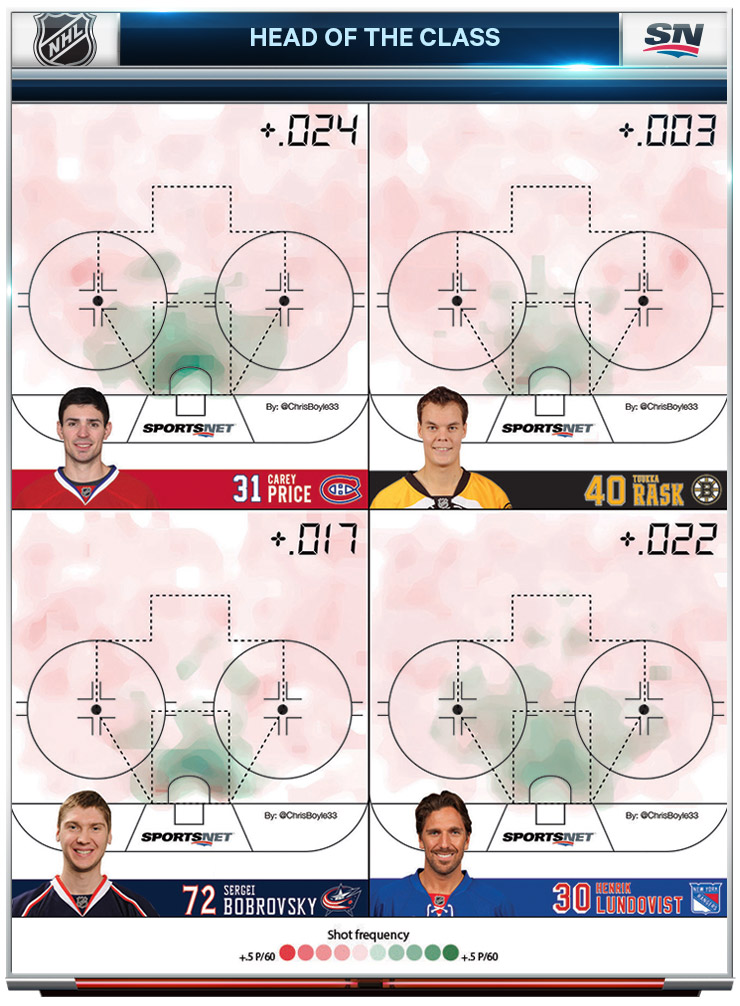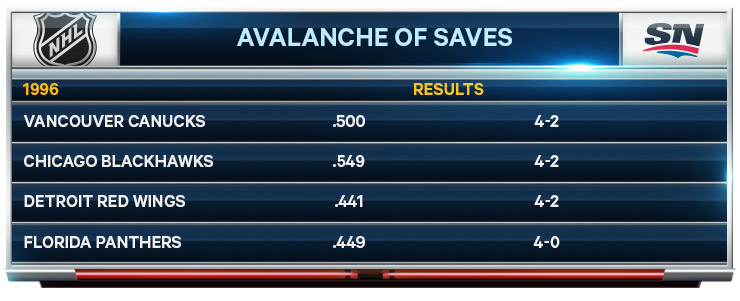The Montreal Canadiens’ Stanley Cup hopes rest squarely on the shoulders of their goalie. It has become a repetitive narrative in Montreal because of the legendary Cup runs of Ken Dryden and Patrick Roy as well as the out-of-the-blue Conference Final runs by Steve Penney and Jaroslav Halak.
This season it is 100-percent true. During the CBC’s recent profile of Carey Price, Peter Mansbridge passed on something that Dryden told him. According to Mansbridge, Dryden said “he was a good goalie on a great team. You (Carey Price) are a great goalie on a very good team.”
Dryden is being humble, but he is right in regards to Price. Price is going to win the Vezina Trophy. Although the Vezina is still voted on, it has reverted to its traditional form recently with save percentage replacing goals-against average. Meet the 50 GP mark and lead the league in save percentage and the Vezina is yours.
In eight of the last nine years, the Vezina Trophy winner has met that criteria. The only year that it didn’t was 2007–08, when Martin Brodeur started 77 games and finished just a couple percentage points behind Jean-Sebastien Giguere and Tim Thomas. Add in his superstar reputation and you can see why he got the votes and became the outlier on the list.
Price has definitely earned it—I have data on the last three Vezina winners, and Price’s 2014–15 season graded better than all of them.
So Price will win the Vezina. The real question, though, is does he deserve the MVP?
One of the interesting theories I read years ago in regards to wins was produced by Philip Myrland, a former Hockey Prospectus writer who ran the blog “Brodeur is a Fraud.” He came up with the Win Threshold, which essentially measures what save percentage a goaltender would need to produce to finish at .500. I ran these numbers for Price and the numbers came back at .908.
So if Price and Dustin Tokarski both produced .908 SV%, the Montreal Canadiens would finish with 82 points. Tokarski finished the 2014–15 season with a .910 SV%. His record? 6-6-4. That’s 16 points in 16 games.
Removing those 16 games, that leaves the Canadiens with 66 games where Price impacted the results. Based on their individual-game offensive output and rewarding the Habs with the exact same shootout/overtime success, the Canadiens would have produced 71 points in those 66 starts with average goaltending. For a grand total of 87 points.
The problem is Price didn’t face an average distribution. The Canadiens are not a good defensive team. Last week I looked at Devan Dubnyk and pointed out environment’s role in a goaltender’s success and how clean looks contribute to that success. Price during the 2014–15 season has been able to mitigate the damage that Michel Therrien’s system exposes him to and has carried the Habs to a 10-5-1 record with a .921 SV% when being exposed to 20 percent or more green-level shots.
When I tracked and ran my numbers Price was responsible for 47 goals above replacement level for an expected SV% of .909. When we compare that to the Win Threshold stat created by Philip Myrland of .908, the Canadiens grade out as a mediocre .500 non-playoff team.
In other words, the fanbase should be counting lottery odds and going over new coaching candidates. Instead, the talk in Montreal is of Price joining the immortals that hang in the rafters of the Bell Center by leading the Habs to a possible Stanley Cup.
The problem is that perception and history don’t quite match up when attempting to place Price in the same sentence as Patrick Roy. Not because Price isn’t a great goaltender, but because Roy never had to drag a poor possession team like the 2014–15 Canadiens to a Stanley Cup.
The Canadiens are one of the worst possession teams remaining in the Stanley Cup Playoffs and poor possession metrics generally don’t lead to positive playoff results. Even through the use of two-period shot metrics (used because there is no historical tracking of blocked and missed shots or html data sheets to separate score effects) we see that outside of the 1980s that poor possession is unlikely to win you a Stanley Cup.
Making the assumption that the Canadiens are likely to lose the possession battles in most of the series they play in, I wanted to contrast how successful Roy was during his playoff career when faced with an opponent outplaying his team. Using the two-period shot metrics available (note: not every year had full boxscores, so I only referenced the available information) at the Hockey Summary Project I checked Roy’s resume against his legend.
The biggest of the Roy legends—how he placed a mediocre Canadiens team on his back and dragging them to their last Stanley Cup in 1993—ignores that they were an above-.500 possession team at .513 and that during their playoff run they held the possession edge in three of the four series they played. The same held true during the 1986 Cup run.

None of this implies that Roy wasn’t great or deserving of the Conn Smythe in either of those seasons, but he didn’t produce those Cups alone. He managed to dominate, but it was behind a strong team with structure. Interestingly enough, the one year where Roy didn’t win the Conn Smythe Trophy during one of his Cup runs was the season where he probably pulled off his greatest performance.
In 1996 the Avalanche knocked off the Detroit Red Wings. While the Avs were a strong possession team themselves at .541, they got bludgeoned by the Wings who were a .579 possession team coming off a 131-point season (pre-loser point) and had a +144 goal differential.
While Roy produced playoff victories while being outshot, when I separated his success into positive and negative possession there was a stark contrast. Roy played in 12 playoff series where his team lost the possession (shot differential) battle. His record in those encounters was 7-5. When his team held the possession edge, it jumped to 18-3.
Expecting Price to pull off a feat that Roy never really did in Montreal isn’t fair. It’s also part of the hyperbole that makes being a goaltender in Montreal so difficult.
Is it possible for Carey Price to drag the Canadiens to a Stanley Cup? Sure. Before the 1993 playoffs began if we discussed the probability of a team winning 10 straight overtime games we would have concluded it as virtually impossible. Before last season, no team had every made the Stanley Cup Final after playing three straight game sevens. Not only did the Kings make the Final, they won the Stanley Cup. So while the odds are against a poor-possession team winning the Cup, anything is possible.
If Price can continue his regular-season dominance through the playoffs, then he will have earned the legend that comes with it. All the odds point against it, but that’s what makes the Stanley Cup playoffs so much fun.





